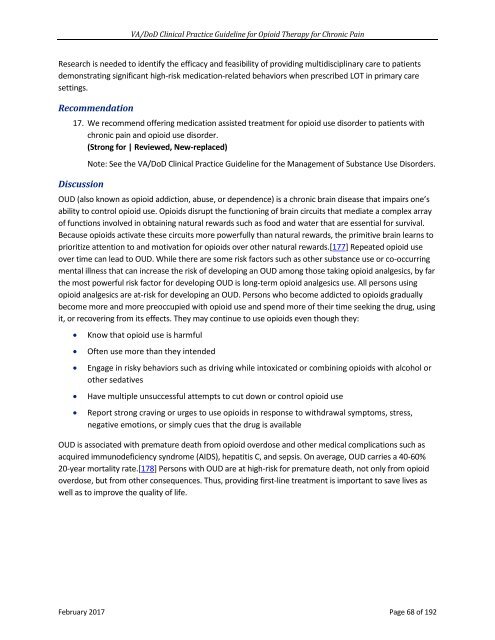VA/DoD CLINICAL PRACTICE GUIDELINE FOR OPIOID THERAPY FOR CHRONIC PAIN
2lfFhbO
2lfFhbO
Create successful ePaper yourself
Turn your PDF publications into a flip-book with our unique Google optimized e-Paper software.
<strong>VA</strong>/<strong>DoD</strong> Clinical Practice Guideline for Opioid Therapy for Chronic Pain<br />
Research is needed to identify the efficacy and feasibility of providing multidisciplinary care to patients<br />
demonstrating significant high-risk medication-related behaviors when prescribed LOT in primary care<br />
settings.<br />
Recommendation<br />
17. We recommend offering medication assisted treatment for opioid use disorder to patients with<br />
chronic pain and opioid use disorder.<br />
(Strong for | Reviewed, New-replaced)<br />
Note: See the <strong>VA</strong>/<strong>DoD</strong> Clinical Practice Guideline for the Management of Substance Use Disorders.<br />
Discussion<br />
OUD (also known as opioid addiction, abuse, or dependence) is a chronic brain disease that impairs one’s<br />
ability to control opioid use. Opioids disrupt the functioning of brain circuits that mediate a complex array<br />
of functions involved in obtaining natural rewards such as food and water that are essential for survival.<br />
Because opioids activate these circuits more powerfully than natural rewards, the primitive brain learns to<br />
prioritize attention to and motivation for opioids over other natural rewards.[177] Repeated opioid use<br />
over time can lead to OUD. While there are some risk factors such as other substance use or co-occurring<br />
mental illness that can increase the risk of developing an OUD among those taking opioid analgesics, by far<br />
the most powerful risk factor for developing OUD is long-term opioid analgesics use. All persons using<br />
opioid analgesics are at-risk for developing an OUD. Persons who become addicted to opioids gradually<br />
become more and more preoccupied with opioid use and spend more of their time seeking the drug, using<br />
it, or recovering from its effects. They may continue to use opioids even though they:<br />
• Know that opioid use is harmful<br />
• Often use more than they intended<br />
• Engage in risky behaviors such as driving while intoxicated or combining opioids with alcohol or<br />
other sedatives<br />
• Have multiple unsuccessful attempts to cut down or control opioid use<br />
• Report strong craving or urges to use opioids in response to withdrawal symptoms, stress,<br />
negative emotions, or simply cues that the drug is available<br />
OUD is associated with premature death from opioid overdose and other medical complications such as<br />
acquired immunodeficiency syndrome (AIDS), hepatitis C, and sepsis. On average, OUD carries a 40-60%<br />
20-year mortality rate.[178] Persons with OUD are at high-risk for premature death, not only from opioid<br />
overdose, but from other consequences. Thus, providing first-line treatment is important to save lives as<br />
well as to improve the quality of life.<br />
February 2017 Page 68 of 192


